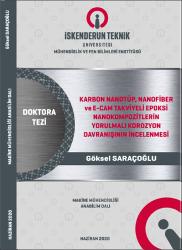| dc.contributor.advisor | Yapıcı, Ahmet | |
| dc.contributor.author | Saraçoğlu, Göksel | |
| dc.date.accessioned | 2020-12-09T12:13:12Z | |
| dc.date.available | 2020-12-09T12:13:12Z | |
| dc.date.issued | 2020 | en_US |
| dc.date.submitted | 2020 | |
| dc.identifier.citation | Saraçoğlu, G. (2020). Karbon nanotüp, nanofı̇ber ve e-cam takvı̇yelı̇ epoksı̇ nanokompozı̇tlerı̇n yorulmalı korozyon davranışının ı̇ncelenmesı̇. (Doktora Tezi). İskenderun Teknik Üniversitesi / Mühendislik ve Fen Bilimleri Enstitüsü, Hatay. | en_US |
| dc.identifier.uri | https://hdl.handle.net/20.500.12508/1480 | |
| dc.description.abstract | Bu tez çalışmasında, katyonik yüzey aktif maddesi kullanılarak homojen dağılımı sağlanmış ve aynı zamanda yüzeyi kimyasal olarak fonksiyonelleştirilmiş olan %0,1 oranındaki çok cidarlı karbon nanotüpe ilave olarak, cam elyaf yüzeyleri silan kimyasalı ile fonksiyonelleştirilmiş ve simetri katında nano elyaf tabaka içeren [0/90] elyaf dizilimine sahip E-cam/epoksi kompozit malzemenin korozyonlu yorulma davranışı incelenmiştir. Katyonik yüzey aktif maddesi olarak CetylPyridinium Chloride, silan malzemesi olarak γ-glycidoxypropyltrimethoxysilane kullanılmıştır. Nano elyaf olarak, elektro-eğirme yöntemiyle üretilmiş olan poliakrilonitril kullanılmıştır. Çok cidarlı karbon nanotüplerin saflaştırılmasında 1:1 oranında sülfürik asit/nitrik asit karışımı, amin ile fonksiyonelleştirmede hekzametilen diamin kullanılmıştır. Üretilen numunelerde nano elyafın, silan uygulamasının ve karbon nanotüp yüzey kimyasının değiştirilmesi işlemlerinin etkilerinin ayrı ayrı görülmesi için ara numuneler üretilmiştir. Tip-I kırılma dayanım ve tokluğunun ölçülmesi için çekme, üç-nokta eğme ve tabakalar arası kırılma testleri uygulanmıştır. Üretilen numuneler, %10 derişimdeki sodyum hidroksit (NaOH) ortamında dört hafta süreyle bekletilmiş ve ortamın etkisi, korozif ortama girmeyen numunelerle kıyaslanmıştır. Üretilen numunelerin, katkısız muadillerine göre ağırlık artışlarının %4,7 seviyesinden %0,7 seviyelerine kadar indiği tespit edilmiştir. Korozif ortamda bekletilen numunelerin kırılma dayanım ve tokluk değerinin ilk iki haftada ciddi seviyede etkilendiği (%54), fakat, iki haftadan sonra, bu kaybın orantılı bir şekilde daha da aşağı seviyelere inmediği ve kontrollü hâlde kaldığı görülmüştür. R=0,1 oranında ve 3 Hz frekansta gerçekleştirilen yorulma testlerinde, korozyona uğratılan numunelerin statik dayanım kaybından dolayı, gerilme-yük çevrim sayısı (S-N) grafiği eğrisinin yaklaşık olarak %76,7 daha düşük eğime sahip olduğu tespit edilmiştir. Üretilen ara numunelerde, en yüksek mekanik değerlerin silanla işlem görmüş ve katyonik yüzey aktif maddesi ile homojen dağılımı sağlanmış karbon nanotüp içeren numunelerden alındığı görülmüştür. Çok cidarlı karbon nanotüpün asit ile saflaştırılması ve sonrasında amin ile yüzey bağlarının oluşturulması işleminin olumlu sonuç vermediği tespit edilmiştir. | en_US |
| dc.description.abstract | In this thesis, the corrosion fatigue behavior of the [0/90] E-Glass/epoxy composite laminate was investigated. In the laminate production, the interface of the fiber-matrix was functionalized with γ-glycidoxypropyltrimethoxysilane. The sulfuric acid/nitric acid solution in the ratio of 1: 1 was used for purification of multi-walled carbon nanotubes and hexamethylene diamine for functionalization with the amine. Cetylpyridinium chloride was used as a cationic surfactant to distribute carbon nanotubes homogeneously. In the symmetry layer of produced laminate, there was a nanofiber mat manufactured from polyacrylonitrile by the electro-spinning method. The semi-finished samples were also produced separately to examine the effects of nanofibre, silane application, and carbon nanotube functionalization on fracture strength and toughness. Tensile, three-point bending, and inter-laminar fracture tests were carried out to measure Mode- I fracture strength and the toughness of the samples. The produced samples were kept in a 10% concentration of sodium hydroxide (NaOH) for four weeks and the effect of the medium was compared with the samples that were not left in the corrosive environment. It was determined that the absorption amount decreased from 4.7% to 0.7% concerning the native specimen. It was found that the fracture strength and toughness values of the samples left in the corrosive environment showed a dramatic decrease of 54% in the first two weeks, but the loss of mechanical properties remained stable from the second week. In the fatigue tests at a frequency of 3 Hz and R = 0.1, it was found that the samples exposed to corrosion had less slope (76.7%) in the applied maximum stress versus the number of cycles to failure (S-N) plots due to the loss of tensile strength. The highest mechanical properties were achieved for samples containing carbon nanotubes treated with silane and homogeneous distribution with a cationic surfactant. It has been determined that the combination of acid purification and amine functionalization does not give positive results in terms of fracture toughness. | en_US |
| dc.language.iso | tur | en_US |
| dc.publisher | İskenderun Teknik Üniversitesi / Mühendislik ve Fen Bilimleri Enstitüsü / Makine Mühendisliği Anabilim Dalı | en_US |
| dc.rights | info:eu-repo/semantics/openAccess | en_US |
| dc.subject | Fonksiyonelleştirme | en_US |
| dc.subject | Kırılma | en_US |
| dc.subject | Tokluk | en_US |
| dc.subject | Korozyon | en_US |
| dc.subject | Yorulma analizi | en_US |
| dc.subject | Functionalization | en_US |
| dc.subject | Fracture strength | en_US |
| dc.subject | Fracture toughness | en_US |
| dc.subject | Corrosion | en_US |
| dc.subject | Fatigue analysis | en_US |
| dc.title | Karbon nanotüp, nanofı̇ber ve e-cam takvı̇yelı̇ epoksı̇ nanokompozı̇tlerı̇n yorulmalı korozyon davranışının ı̇ncelenmesı̇ | en_US |
| dc.title.alternative | Investigation of corrosion fatigue behavior of carbon nanotube, nanofiber and e-glass reinforced epoxy nanocomposites | en_US |
| dc.type | doctoralThesis | en_US |
| dc.contributor.department | Mühendislik ve Fen Bilimleri Enstitüsü | en_US |
| dc.relation.publicationcategory | Tez | en_US |
| dc.contributor.isteauthor | Yapıcı, Ahmet | |
| dc.relation.index | İndeks Bilgisi Yok | en_US |
















